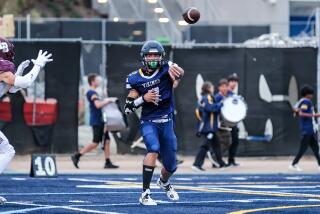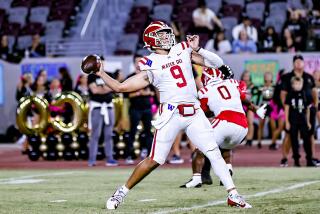It’s a Bone-Jarring Good Time : Rugby: Sport that started in 1820s is gaining popularity in Southern California.
- Share via
Kai Takarabe came to the United States from Japan in 1961 to be a student.
He stayed and became a U.S. citizen so he could be a teacher.
Takarabe, however, has never been confined to a classroom. For almost 30 years, he has played, coached and taught the game of rugby in Southern California.
Takarabe, 49, is the founder and director of the Pasadena-based Crown City Rugby Club, one of four clubs based in the San Gabriel Valley.
“There are many great things about this country that I love,” said Takarabe, who has taken teams on competitive tours of more than 30 countries. “And even though rugby is not a major sport like football in the U.S., it’s what kept me here.
“It’s a game that brings people together from all walks of life. In our club we have players of all races who are city workers, construction workers, teachers, lawyers--you name them, we got them.”
Like Takarabe’s Pasadena club, the Pomona Valley Rugby Football Club competes in men’s divisions under the auspices of the Southern California Rugby Football Union.
Cal Poly Pomona and the Claremont colleges field collegiate-level club teams that compete under SCRFU guidelines against schools such as Occidental, Cal Lutheran, Loyola Marymount, USC, Pepperdine, Redlands and UC Irvine.
The organization also oversees play in a men’s under-19 and women’s and men’s open divisions.
Rugby, which has its origins in England and dates back to the early 1820s, is played on a field or “pitch” that measures 100 meters by 70 meters. Traditional rugby has 15 players on a side, who attempt to score points by running, lateraling and kicking what looks like an oversize football into an in-goal area. No forward passes are permitted.
The object is to advance the ball across the goal line, where a player can touch it down for a, “try,” which is worth four points. Like football, the team not in possession of the ball attempts to stop the other by tackling players.
For some, the physical aspect is the main appeal of the game. Bone-jarring collisions, sustained without the benefit of protective padding, are common.
But whether they begin playing the sport in college or after another part of their athletic career is over, most rugby players say they adopt the game for life. And almost every rugby player admits that the highlight of the experience is the, “third half,” the traditional postgame party that fosters camaraderie without peer in any other sport.
“It’s not like football where you shake hands after the game and never see the guy you’ve been pounding on again,” said Karl Davis, 43, of Pasadena, who has been playing rugby for 27 years. “You get to know and like the people you’re playing against.”
Said Raymond Viers, the coach at Cal Poly Pomona: “Rugby is a sport where you respect the fact that you won and you respect the fact that someone lost. That camaraderie becomes stronger as the quality and seriousness of the competition grows.”
From a participant’s perspective, the other major appeal of rugby is the involvement it allows for every player.
Alan Cameron of Diamond Bar began playing the sport at Cal Poly Pomona after the university dropped its football program after the 1982 season. Cameron, who was a running back at Hemet High, had been discouraged when he learned that he would be unable to continue his football career.
But his sadness only lasted until his first rugby scrum.
“In football, you have your backs and linemen, and the linemen are unglorified--they don’t get to do much other than block,” said Cameron, 27, who plays for the Pomona Valley Football Rugby Club. “In rugby, each person on the field can pick up the ball and run with it and score. It doesn’t matter what position you play, you’re always involved.
“And it’s a continuous game, a complete momentum game.”
Because rugby is not an official sport sanctioned by the NCAA, it fits in well at college campuses such as Claremont-Pomona, which played its first rugby match in 1906 against UCLA.
“A kid can be an athlete and still be student,” Claremont Coach Wally Cox said. “We want the players to come to practice, but if they have school, well, they have school.
“We work hard without demanding a four-hour commitment every day. It works really well here.”
Rugby clubs in Southern California are completing their summer tournament schedules. They will soon begin practicing for the regular season, which includes tournaments from October through December and divisional play starting in January.
Takarabe and the Crown City club will play host to a team from Fiji on Saturday at the club’s home pitch in front of the Rose Bowl.
Next year, Takarabe will be taking his team to Korea as he pursues his continuing mission of international goodwill.
“The tours and the camaraderie allow you to make friends all over the world,” Takarabe said. “That’s what rugby is all about.”
Area Rugby Clubs
* Pasadena-Crown City Rugby Club: Practice field, Victory Park; Home field, Area H of Rose Bowl; Information: (818) 796-9517.
* Claremont Colleges Rugby Club: Practice field, Merritt Field; Home field, Merritt Field; Information: (714) 626-5322.
* Cal Poly Pomona Rugby Club: Practice field, Bronco Field; Home field, Bronco Field; Information: (714) 626-1160.
* Pomona Valley Rugby Football Club: Practice field, Ralph Welch Park in Pomona; Home field, Ralph Welch Park; Information: (714) 946-0563.
More to Read
Get our high school sports newsletter
Prep Rally is devoted to the SoCal high school sports experience, bringing you scores, stories and a behind-the-scenes look at what makes prep sports so popular.
You may occasionally receive promotional content from the Los Angeles Times.







